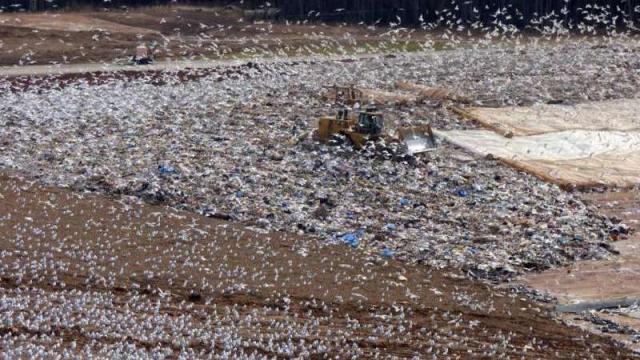Where there are landfills there are seagulls. An estimated 1.4 million of these opportunistic feathered critters feed on these vast tracts of waste across North America. And as a new study from Duke University shows, the voluminous amounts of poop from these gulls is compromising the water-quality of nearby lakes and reservoirs.
Image: Scott Winton
Landfills provide sustenance for seagulls, which greatly increases their numbers. This is well documented, but the environmental impact of these birds has been largely ignored. A new study published in the journal Water Research is now the first to look at the magnitude and geographic scope of landfill gulls, and to quantify the amount of nutrients they’re depositing into nearby lakes and reservoirs through their landfill-fuelled crap.
The numbers are staggering. According to the new research, an estimated 240 extra tonnes of nitrogen and 39 extra tonnes of phosphorus are plopped into these water systems each year across North America. Under normal circumstances, a little bird poop — filled with many beneficial nutrients — wouldn’t be anything to worry about. But all of this added seagull crap is contributing to extensive algal blooms, which sucks a tremendous amount of oxygen from the water. This results in mass fish kills, and the proliferation of algal toxins across precious water bodies. Algal blooms also degrade recreational and fishing areas — not to mention the increased costs for local governments that have to deal with them.
“It costs local US governments an estimated $100 million [$132 million] a year in nutrient offset credits to address or prevent the problem and maintain nutrient levels at or below the total maximum daily load threshold for water quality,” noted study co-author Mark River, a doctoral student at Duke’s Nicholas School, in a statement.
[referenced url=”https://gizmodo.com.au/2016/07/gross-algae-bloom-engulfs-a-lake-full-of-human-shit/” thumb=”https://img.youtube.com/vi/jMzfRcqEE7Y/maxresdefault.jpg” title=”Gross Algae Bloom Engulfs A Lake Full Of Human Waste” excerpt=”The United States is in the dog days of summer, which means disgusting algae blooms are cropping up across polluted and poorly managed waterways all over the country. The latest slime-covered coastline to grab headlines? Utah Lake and it seems that actual human crap is to blame.”]
For the study, the researchers looked at data found in the eBird Citizen Science database, which collects information about bird populations through documented sightings. The data suggests that 1.4 million seagulls loiter around landfills across all of North America, but the researchers suspect the number is much higher — perhaps as high as five million. “That means the amount of nutrients deposited in the lakes, and the costs of preventing or remediating the problem, could be substantially higher,” said study lead author Scott Winton.
River and Winton also conducted field work, visiting two landfills near two major drinking water reservoirs — Jordan Lake and Falls Lake — which serve the Raleigh-Durham region of North Carolina. The data collected at these sites was used to get an better sense of the poopy process, and to extrapolate these findings across the entire continent.
At Jordan lake, for example, they found that a local flock of 49,000 ring-billed gulls were depositing landfill faeces containing nearly 1.2 tonnes of phosphorus into the lake each year. That’s equal to about half of the total phosphorus reduction target established for the lake by local authorities. In terms of costs, the local government is forced to pay about $US2.2 million [$2.9 million] each year to offset the problem, which it does through long-term programs that work to reduce other sources of incoming nutrients, such as urban stormwater and agricultural runoff.
In terms of solutions, the researchers say waste authorities need to reduce the size of their open landfills, and cover the garbage more quickly after it’s dumped. That would reduce the seagull population dramatically, and force the remaining birds to earn an honest living on beaches. And the parking lots of shopping centres.
